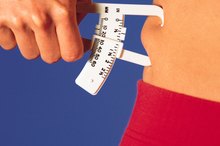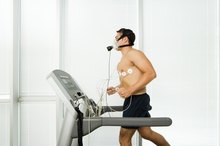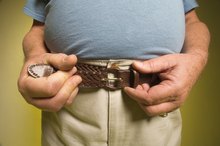How to Calculate Physical Activity Level
A person's physical activity level is a numeric method of expressing one's daily energy expenditure. Which is to say, it's a number given to what is done in a day. The amount of physical exertion in one day determines how many calories must be consumed in the same period to maintain activity and lose or gain weight as desired. Physical activity level (PAL) takes into account total daily energy expenditure (TDEE) and basal metabolic rate (BMR). The equation can be written as:
PAL = TDEE / BMR
Calculate BMR.
An accurate calculation of BMR can only be done through specifically designed tests conducted when the digestive system is inactive (after 8 hours of sleep, 12 hours without food). Without proper testing the BMR can only be estimated, with the closest approximation coming from the Harris-Benedict equation, which was once the standard for BMR measurements but has since been proven to overestimate by 5 percent or more. Considering the number of factors which are involved in proper BMR calculation, including body surface area, body temperature and health, external temperature and gland function, completely precise BMR results can't be done in a simple equation, however, Harris-Benedict remains the best practical estimation available without proper testing. The equations use the variable of weight (w) in kilograms, height (h) in centimeters and age (a).
For men: BMR = (13.75 x w) + (5 x h) - (6.76 x a) + 66
For women: BMR = (9.56 x w) + (1.85 x h) - (4.68 x a) + 655
How to Check Your Weight Without a Scale
Learn More
Calculate TDEE.
TDEE takes into account the number of calories used in day both at rest (BMR) and during physical activities. Again, accurate rating uses height, weight, age, body type and gender. Devices such a pedometer (which counts the number of steps taken in a day) can be used to reasonably determine TDEE. There are also tests, such as the double-labeled water test which estimates the amount of carbon dioxide and water the body produces over the course of two to three weeks. Rough equations for TDEE (as a measurement of calories used) can be attained through the following equations:
For sedentary people (office workers who rarely or never exercise): TDEE = weight (in pounds) x 14
For moderately active people (construction workers, those who exercise or play a sport 3 to 5 times a week): TDEE = weight (lbs) x 17
For active people (agricultural workers, those who exercise or play a sport daily): TDEE = weight (lbs) x 20
Place TDEE and BMR into the equation for physical activity level (PAL). General activity levels are expressed as:
Inactive: less than 1.4
Sedentary: 1.4 - 1.69
Moderately active: 1.70 - 1.99
Vigorously active: 2 - 2.4
Extremely active: greater than 2.4
Related Articles
References
Writer Bio
Jess Kroll has been writing since 2005. He has contributed to "Hawaii Independent," "Honolulu Weekly" and "News Drops," as well as numerous websites. His prose, poetry and essays have been published in numerous journals and literary magazines. Kroll holds a Master of Fine Arts in writing from the University of San Francisco.








